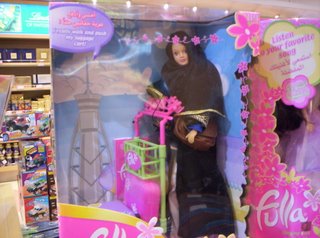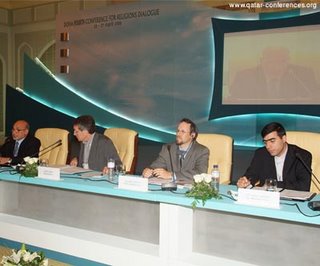Dear readers,
I'm leaving for Doha tonight - to speak at a religious dialogue conference. Here's a draft of my speech - which may go through some changes in flight....I'll update on my return.
Daniel
Inter-religious Dialogue and Environmental Protection
Doha Conference on Religious Dialogue
April 26, 2006
Address by Rabbi Daniel S. Brenner
Auburn Theological Seminary - New York City
I begin with words of prayer from Psalm 148:
Exaltations to the Holy One! Mountains and hills, fruit trees and all cedars, wild animals and all cattle, creeping things and flying birds, give thanks to God!
First, my gratitude to His Highness the Emir of Qatar. Your openness to religious diversity and dialogue is an example to all world leaders. Your vision to initiate this gathering is commendable, your commitment to sustain it is deserving of praise. And now I understand why so many say that your hospitality is unrivaled. I also wish to thank those on the faculty of the University of Qatar and those who work for the embassy of Qatar and all others who have made it possible for this extraordinary event to take place.
My thoughts today are drawn, in part, from the reality that the beautiful body of water whose shores we are on now has suffered great ecological damage, mostly due to the spills and fires produced by wars between nations. While the Gulf continues to recover, the only thing that will insure its return to health will be peace and stability in the region. May God bless His Highness with the patience and wisdom to carry out his vision of Qatar being the place where enemies reconcile and new relationships are born.
As a child growing up during the tail end of the cold war, I often had nightmares of the mushroom clouds and the radioactive rains of a thousand Hirsoshimas. In the summer, when I would accompany my father to synagogue to read the Book of Lamentations, ascribed to the biblical prophet Jeremiah, I would hear a slow sad chant of the destruction of Jerusalem
Those who feasted on delicacies perish in the streets;those who were brought up in purple cling to ash heaps. (Lamentations 4:5)
I would imagine such a destruction ripping through suburbia. And I would dream of a getaway plan.
How could one escape such a nuclear disaster? A disaster that would make large parts of the earth uninhabitable?
It seemed like there were two options – either sail-off to a remote island off the coast of Chile or jump aboard a giant rocket propelled spacecraft – a modern Noah’s Ark – a genetic lab of all that lived on earth, and head out into space. In either place, I imagined, we few survivors would start a new life and build a utopian community.
The science fiction answer to environmental devastation – either devastation wrought by world war or wrought by the power of one mutant virus – seems like the twenty-first century’s preferred mode for escape. As we sit here now, up above us the International Space Station is orbiting. Anthropologist John Moore estimated that it would take only 160 humans to preserve the human species in space for centuries until they can repopulate earth. Unfortunately, the entire crew of the International Space Station is currently all men.
The Space Studies Institute has identified the number one priority for future space colonization to be the perfection of a totally closed environment life support system. Biosphere 2 in Oracle, Arizona, brought together the world’s leading scientists to do just that. They spent over 200 million dollars to build a 7,200,000-cubic-foot sealed glass and space-frame structure containing 5 biomes, including a 900,000-gallon ocean, a rain forest, a desert, agricultural areas and a human habitat. They succeeded in creating a giant sunny airtight warehouse where nothing can breathe or live. It will now be modified and turned into a conference center.
A space colony that operates independently of earth is not in the foreseeable future. So the other escape seems more compelling. The escape away from the electrical grid – the escape backward – a return to a simple life of rudimentary agriculture and a smaller human population. The leader of the animal rights group People for the Ethical Treatment of Animals, Ingrid Newkirk, argues that "Humans have grown like a cancer. We're the biggest blight on the face of the earth." Apparently in the developed world, people of my generation are listening to her – and they are not particularly interested in having children. This is especially true in Italy, Japan, Germany, the Czech Republic and Austria where birth rates are falling below death rates. Those on the most extreme end of the environmental movement who say that our ultimate goal as a species is to reduce our human numbers 400-fold. I wonder: Who gets chosen to have children? Who decides? It sounds to me like a veiled plan for forced sterilization and indirect genocide.
What does all this have to do with inter-religious dialogue and environmental protection?
It seems to me that the role of religions leaders at this hour, especially the role of those of us in monotheistic religions, is to say loudly and clearly that there is no escape from our responsibility towards the natural world – there is no escape to outer space or to forests in far corners. In the words of the Psalms we Jews sing each Sabbath, “the Heavens are for God, and the earth is given to the children of Adam.” Heaven may be an unpolluted garden of delights – but God has instructed us to take responsibility for the earth right here and right now, to work together to harness the best of what technology offers us and to utilize our own self-control to reduce waste and promote sustainable development. This should be the top priority for inter-religious dialogue. I commend all those who planned this conference for putting it on the agenda.
Our seminary runs an educational program for young people – Christians, Muslims, and Jews – entitled Face to Face/Faith to Faith. The students come from Africa, Europe, the Middle East and the U.S. In the summer, when they come to New York, I ask these young people the question: “If you think that we are learning from history and that the world is becoming a better place to live, would you please raise your hand?” Very few hands go up. This, my friends, is a serious concern.
When I was a child, I would travel with my family to the tropical climate of Florida to visit my grandparent’s home. In the back yard were magnificent orange trees and grapefruit trees. Each morning my grandfather and I would go out back, pick fruit, and squeeze juice for breakfast. When he became sick and died and eventually my grandmother had to sell the house, the first thing that the new owners did was to chop down the trees and build a parking lot.
In my heart, my grandfather’s death and the death of the trees are inseparable. The story is a parable about what we in the developed world have done to the forests of the planet and the people of the developing world in the last generation. Young people are very aware of this destruction. And they are looking for religious leaders who are willing to be a voice that reminds government and business leaders of our responsibilities to the earth.
One of the other things that I have learned in working with the teenagers of the Face to Face program is that as the world becomes increasingly commercialized, the spiritual thirst grows. While religious extremists quench this thirst with visions of global domination and social purity, we who believe in human progress must foster a vision that sees diversity at its heart. Diversity not simply in the marketplace – but diversity in terms of the books one can find in the library, cultural diversity, religious diversity, and beyond. There is no better model for this diversity than the bio-diversity of the planet.
A teaching from the sages on the Book of Ecclesiastes:
In the hour that the Holy Blessed One created Adam, the first earthling, he took him and let him pass before all the different species of trees of the Garden of Eden. The Holy One said: “See my works, how fine and excellent they are! All that I have created, this has been done for your life. Reflect on this, and do not corrupt or destroy My world, for if you do, there is no one to straighten it up after you.” (Kohelet Rabbah 7:28)
The spiritual path is the path that follows Adam’s footsteps – to walk the land and pass before each species of tree in awe and gratitude. God intends us to understand bio-diversity and to protect bio-diversity. From the Tower of Babel story we learn that God does not desire that we speak one language, or that we form one empire. God desires diversity.
The first step in an inter-religious dialogue on environmental protection is often a simple acknowledgment that there are sources within each of our traditions that guide us in understanding our responsibility to protect and preserve the natural world. When we share these stories across religious traditions we are supporting one another in the shared work of protecting the planet. I want to conclude with what I believe to be two other critical steps.
The second step in inter-religious dialogue on the environment is that we build a bridge between religious leaders and those in the scientific community who are working to address ecological concerns. At Auburn Theological Seminary, we have been gathering religious leaders – Christians, Muslims, and Jews - to participate in a week long seminar which is lead by a biologist from Columbia University. We spend a day on cosmology and creation, a day on evolution and genetic mutation, and a day on the origin of human consciousness. In the seminar, science and religion are in dialogue, and we who are concerned with spiritual matters must turn our attention to the earth.
The third step is for religious leaders to work with government and business leaders to address the two factors other than war that are driving us to destroy the environment - poverty and wealth. Those who are poor strip the natural world for their own survival. Those who live in comfort are stripping the natural world for the sake of convenience and greater wealth. The ethical question we must ask is: Exactly how much of the natural world’s resources is one nation, one group, or one person entitled to use? What are the limits? What are the responsibilities of resource rich countries to those who do not even have seeds to plant trees? The United Nation’s Millennium Development Goals are a noble effort to respond to these questions. Each of us should publicly lend them our support.
I began this address with my fears about nuclear war and ecological catastrophe. I want to end with my hopes for inter-religious cooperation. My friend Rabbi Michael Cohen, works for the Arava Institute for Environmental Studies which brings Israeli, Palestinian, Jordanian and other graduate students together to study desert ecology. The students, Jews, Christians, and Muslims study stream restoration, sustainable agriculture, and issues related to the body of water that is called in English the ‘Dead Sea’ that lies between Israel, the Palestinian Authority and Jordan. On a walk with Michael, he laughs as he tells me “We are trying to bring the Dead Sea back to life.” But it struck me as a perfect metaphor for religious leaders and the natural world. Let us work together to restore life to the planet – beginning with the lowest point on earth and working our way skyward. Could there be any better way to praise the Holy One?






